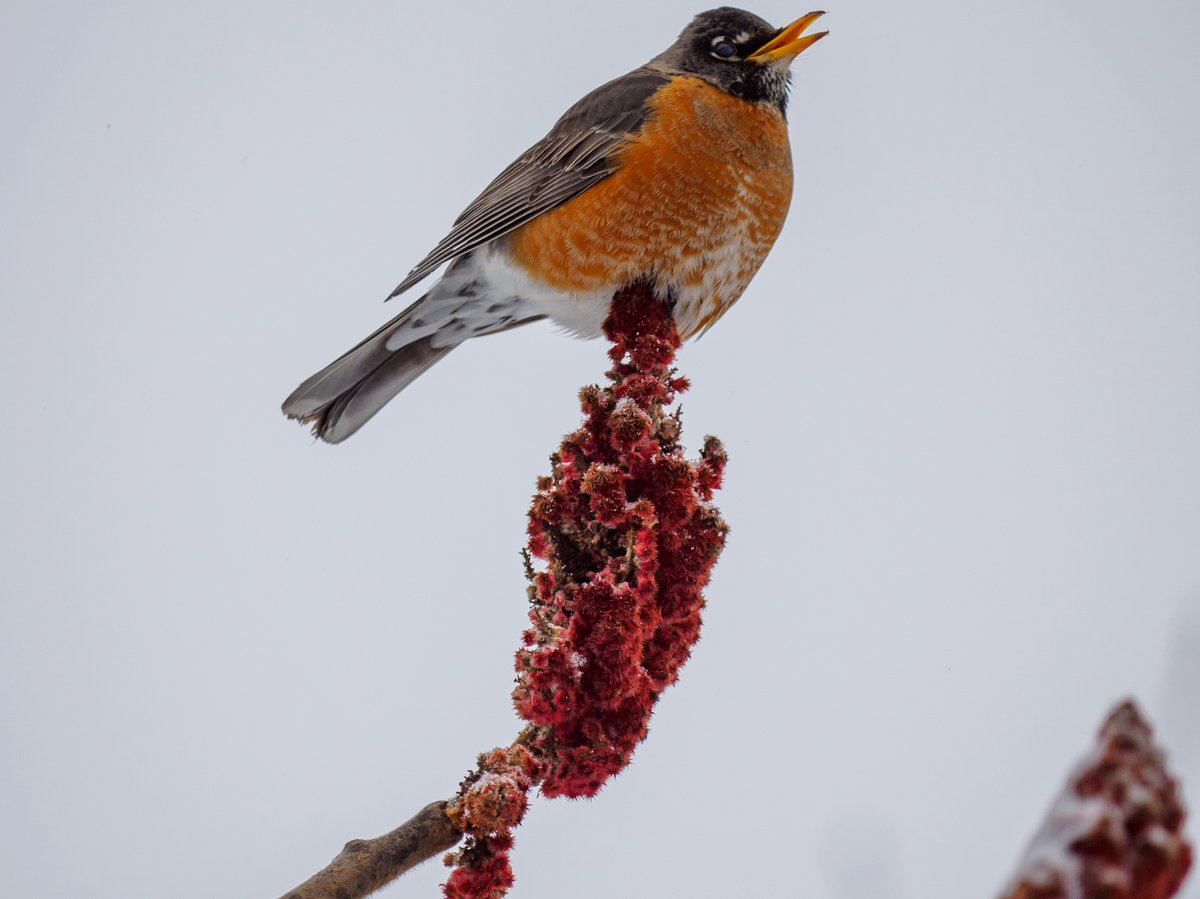Winter in the Finger Lakes is a season of cool colors. The sky, lakes, and snow are a palimpsest of azure, white, steel-blue, and gray. Sometimes, the only warm-colored brushstrokes in this austere landscape are the maroon berry clusters of the staghorn sumac (Rhus typhina).
The bobs, as they are sometimes known, remain on bare stems throughout the winter, like paintbrushes or frozen candle flames. The berries have little flesh and their very large central seeds contain little fat; as a result, they do not go rancid and make an excellent emergency food source for many animals. Deep in mid-winter, when food is hard to find, these muted red beacons attract many species of birds. Squirrels, rabbits, and deer ignore bitter alkaloids to browse on any parts of the plant that they can access. By late winter, any remaining bobs have shriveled to a deep brown.

Photo: Chris Ray
The staghorn sumac is at once striking and utterly forgettable. Its large fronds of pinnately compound leaves make it seem curiously out of place, like an escaped hothouse plant. Although it can propagate from seed, it tends to form luxuriant clumps that are created when parent plants send out multiple shoots from underground rhizomes. Appropriately enough, the staghorn sumac belongs to a mostly tropical botanical family, the Anacardiaceae or cashew family, which also includes mangoes and pistachios. A few other members of this lineage are found in North America, including the similarly named but distantly related poison sumac, a small and toxic tree of bogs and swamps.
The poison sumac’s name is something of a misnomer: its berries are white, but the word “sumac” in fact comes from the Arabic word for “red.” It is the distinctive color and shape of the berries and twigs that have inspired most of the plant’s monikers. The staghorn sumac’s scientific name, Rhus typhina, refers to both the redness of its bob and its resemblance to the cattail, another plant whose seedheads make striking shapes against the winter sky. It gets its picturesque common name from the fact that its young twigs, like its berries, are covered with wine-colored hairs, like the velvet-covered horns of stags in spring.
Despite its unusual features, the staghorn sumac is so common that it usually escapes notice. It is an in-between plant, a large shrub or a small tree or an amorphous thicket. It thrives in unshaded, poor soil and is ubiquitous on roadsides and forest edges, in old fields and empty lots. It has a habit of suckering that annoys gardeners and tends to disappear into the vegetation – except in fall, when its leaves are the first to turn bright red, and in winter, when its bobs are outlined in sculptural splendor against the horizon.
Although it has no commercial uses today, this plant has been long used by humans. The berries and shoots are edible, and archaeological evidence shows that the former have been eaten for thousands of years. They can be soaked in water to make a pink beverage known as sumacade or Cherokee quallah, and the liquid can also be jellied. When the berries are toasted and ground, they become the tart crimson spice known as sumac, which is used in Middle Eastern cuisine. (The sumac found in spice shops is technically Tanner’s sumac (Rhus coriara), a Eurasian species. It was used by the Romans long before they had lemons.) Various parts of the plant can be used to produce dyes from black to yellow to red, and the leaves and fruits make a black ink. The branches can be woven into baskets; candles can be made from the oil in the seed; beekeepers burn the bobs to make a cool smoke to calm angry hives; the sap can even be used as glue. It is a veritable pharmacopeia, too: all of its parts have medicinal value.
Though we tend to have little affection for it in New York, staghorn sumac was once prized not only for its practical uses but for its exotic beauty. It was brought to Europe in the early seventeenth century as an ornamental and was cultivated in botanical gardens for centuries. Unfortunately, its easygoing but tenacious personality, as well as the fact that it can thrive in a very wide range of environments (it is native from Quebec to Georgia) means that when it finally escaped, it became one of North America’s most successful exports. It now spreads its hardy tropical fronds in forest clearings and along railroad tracks almost everywhere in Europe.

